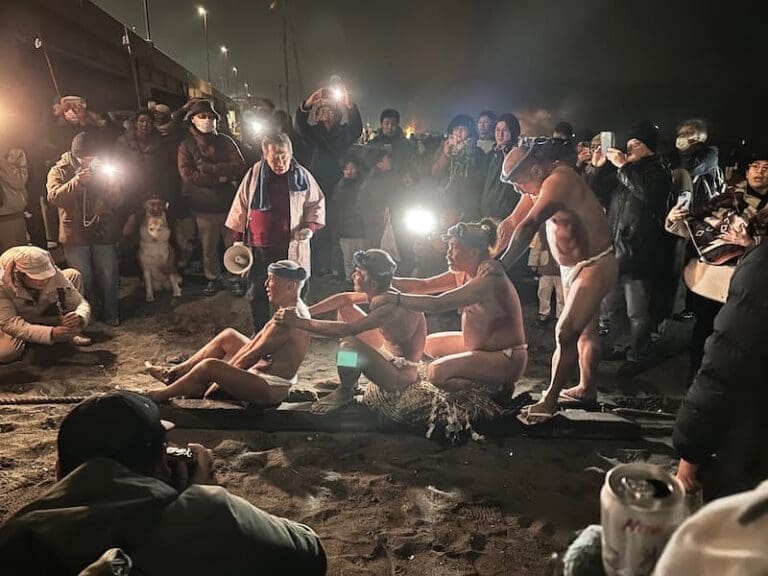Just an hour away from Tokyo by train, Oiso is ideal for people who want to escape crowded tourist spots and experience the charm of a quiet Japanese town. As a historic fishing town and the site where Japan’s first public beach opened in 1885, Oiso still carries a relaxed seaside atmosphere. It’s also a great destination for architecture enthusiasts, with beautifully preserved and renovated old houses once owned by notable figures, now open for visits.
In this guide, you will find the perfect itinerary for a day trip or overnight stay in Oiso. I’ve also highlighted the main event that puts Oiso on the map: the Sagicho Festival, a spectacular fire festival held every January.
Oiso in a Nutshell
If you’re short on time, here’s the perfect Oiso itinerary in a nutshell to help you plan your trip.
Best Time to Visit: Autumn is ideal for enjoying the fall colors, making places like Joyama Park even more beautiful. Visit in January for the Sagicho Festival. Summer is perfect for those seaside town vibes.
Duration: A day trip works, but I recommend staying overnight if you want to have time to relax and explore the town’s sightseeing spots without rushing.
How to Get There: Oiso is about an hour from Tokyo Station on the JR Tokaido Line. Get off at Oiso Station, and most places of interest are a short walk or bike ride away.
Things to do: Visit the preserved historical houses, dating back 50 to 100 years, to appreciate traditional Japanese architecture at Meiji Memorial Garden, Shigeru Yoshida’s Residence, and Former Toson Shimazaki Residence. Take a stroll through the town, along the beach, and in the parks to experience local Japanese life.
Where to Stay: The Oiso Prince Hotel is the top option. Its convenient location by the beach, great onsen, and comfortable rooms make it a perfect choice for both relaxing and sightseeing.
Things to Do in Oiso
Below, find the best things to see and do in Oiso. I’ve listed the places of interest in the order you should visit them, starting from the closest to the furthest from the station. You can follow this itinerary as is.
1. Shigitatsuan (Haiku Dojo)
Shigitatsuan is one of Japan’s top three haiku dojo (I didn’t know that was a thing either before visiting Oiso) where people learn and practice haiku poetry. From the street, you will notice its thatched roof and the greenery surrounding it. It’s a place full of history and even if you’re not into poetry, the traditional teahouse-style building and its charm make it worth visiting.
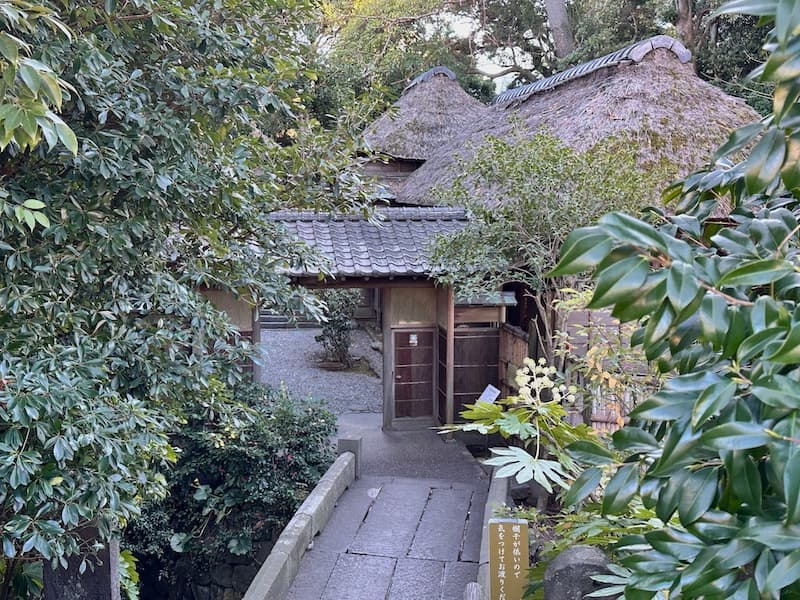
It’s also a short walk from the station and on the way to the sightseeing spots listed below, which makes it easy to fit into your itinerary.
Location: https://maps.app.goo.gl/kocHCwdCaEeNixoX9
2. Former Toson Shimazaki Residence
The old Toson Shimazaki Residence in Oiso is where the renowned author spent his final years before his death in 1943. The house, known as “Shizuka no Kusa-ya” (Quiet Grass Hut), reflects his preference for simplicity. It’s a modest single-story structure with cedar bark walls and rare Taisho-era glass sliding doors.
Surrounded by a small garden featuring young leaves of kaname and mochi trees, as well as seasonal flowers like morning glories and bush clovers, the residence offers a glimpse into Shimazaki’s life. He found comfort in this setting, referring to the house as his “quiet grass hut”.
It’s only 200 meters from Shigitatsuan and the way to the third item on this list.
Location: https://maps.app.goo.gl/Fjrrd8RLprScxYhD8
3. Former Tokaido Pine Trees
I personally wouldn’t exactly call this a sightseeing spot, and you might pass by without noticing. But since it’s on the way to the next place of interest, I thought I’d mention it.
The Former Tokaido Pine Tree-lined road in Oiso is a remnant of the old Tokaido highway from the Edo period. Over 400 years ago, pine trees were planted along the route to provide shade and guide travelers. In Oiso, sections of these pine-lined paths still exist, with one located on the main road that passes by Oiso Junior High School and leads to the Meiji Memorial Garden, our next stop on this list.
Location: https://maps.app.goo.gl/mDCMLYARwfAHKnA46
4. Meiji Memorial Garden
This is my favorite place in Oiso. The garden has beautifully preserved historical houses that give you a look at how life was like for some of the wealthiest and most powerful Japanese people 100 years ago.
The houses are spacious, built in a gankou-zukuri style (雁行造り) or flying geese style, meant to allow natural sunlight into all rooms of the house by ensuring no spaces are blocked by other parts of the structure.
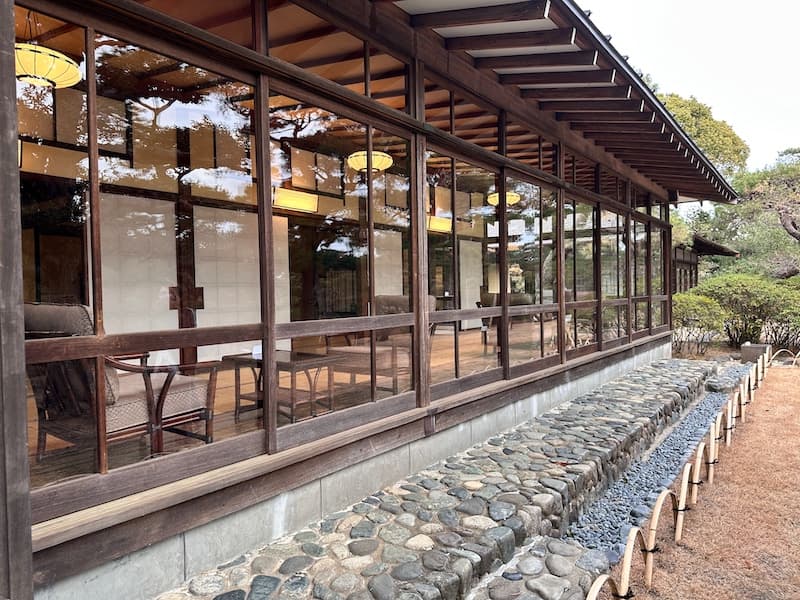
Their architecture and interior are also stunning, combining traditional Japanese design with a touch of Western influence.
Walking through the houses, you can see how each room was designed with purpose. For example, the houses are slightly elevated and the window are positioned in a certain way that frames the view like a painting when you sit on the tatami.
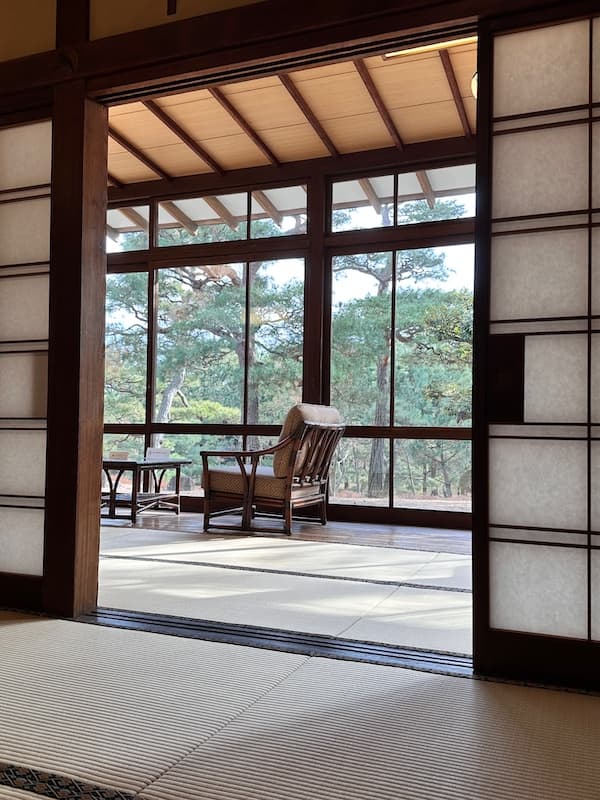

There’s no furniture inside the houses so they can feel empty, but one of them has a furnished kitchen and bathroom with everyday objects like plates and utensils, which makes it easier to imagine what life was like back then.
Location: https://maps.app.goo.gl/1XBaSdAREvNiD2CP9
5. Oiso Joyama Park
Oiso-Joyama Park is a peaceful spot for a walk, with paths winding through trees, the local history museum, and a tea house at the entrance. The park is especially beautiful in autumn when the leaves turn red and orange. If you’re in Oiso during the fall, it’s definitely worth visiting for the seasonal colors. Otherwise, the park is a good addition to your trip but not a highlight on its own.

One thing that makes it stand out though, is the view of Mount Fuji and the Izu Peninsula from the top. On a clear day, the view is amazing, but it depends entirely on the weather—so it’s a bit of a gamble.
The tea house at the entrance is worth checking out. Its traditional tea garden around it create a calming atmosphere, and you can enjoy the scenery while sitting inside. It’s perfect for a short break.

Location: https://maps.app.goo.gl/hEbVbtzCKfzGjAwg9
6. Shigeru Yoshida’s Residence
The Former Residence of Shigeru Yoshida in Oiso is where Japan’s post-war Prime Minister spent his later years. Originally built in 1884 by his adoptive father, the house became Shigeru’s main residence from 1945 onwards. The property showcases traditional Japanese architecture, including a thatched roof and traditional gardens reflecting the style of the era.
You can explore the restored rooms and see how Yoshida lived during his time here. The estate also includes the Kabuto Gate and the Seven Sages Hall, which are recognized as cultural properties. It’s located just across the road from Joyama Park, so be sure to visit both places one after the other.
Location: https://maps.app.goo.gl/1tJXzgS7MtxpFpbX6
7. Oiso Beach and Oiso Connect
Oiso Beach is a great spot for a walk or to just sit and enjoy the view. It’s not as famous as beaches like Kamakura or Enoshima, so it feels quieter and less touristy. It’s especially nice in the morning or evening when it’s peaceful and you can really enjoy the coastal vibe.

Location: https://maps.app.goo.gl/f2ZrweMAFEG6yNWe7
Right next to the beach, you’ll find Oiso Connect, a large building that opened in 2021 that stands out with its modern design in this otherwise traditional town. Inside, there’s a shop selling local products on the first floor and a modern café with ocean views on the second floor. The pancakes here might look massive, but they’re surprisingly easy to eat. You can’t go wrong with any option, but if you ask me, the banana chocolate is the one to try.
Location: https://maps.app.goo.gl/yWLVNpB2zCVCeAPX8
8. Relax at the Oiso Prince Hotel
This might seem unusual to include in a “things to do” list, but the Oiso Prince Hotel is a destination in itself. Many people come to Oiso just to stay at this hotel because it’s affordable and offers great facilities. The onsen looks modern and luxurious, and while the spa costs an additional ¥1,600, it’s mixed and provides several types of baths and rooms, and an infinity pool with stunning ocean views.
The rooms are beautiful and comfortable, with options for either a mountain view or an ocean view. The multi course dinner features a buffet for starters and desserts, with a plated main dish that feels like it came from an expensive restaurant.

I didn’t expect to find such a fine hotel in Oiso, and was genuinely impressed. Especially considering the price—only slightly more expensive than the cheapest low-end hotels in Tokyo. It’s a great way to relax after exploring Oiso and would recommend staying overnight if your schedule allows.
Where to Eat in Oiso
You probably won’t have more than two or three meals in Oiso, depending on whether you stay overnight. Here are the best options to try some local, popular restaurants and specialties:
Hayashi-tei
Tonkatsu restaurant located about a 5-minute walk from the station. The wooden interior is cozy and retro, and the food is excellent, with generous portions.


Location: https://maps.app.goo.gl/n5aNgWdob2rdBBc67
Sugimoto Chicken Restaurant
Sugimoto looks like a classic, old-style Japanese restaurant. As the name suggests, they specialize in chicken dishes like karaage (fried chicken) and yakitori (grilled chicken). Just note that they only accept cash.
Location: https://maps.app.goo.gl/pduxAHTk9Q3agusaA
Oiso Connect Café
I already mentioned Oiso Connect above for its pancakes. But it also serves breakfast and proper meals. The particularity is that everything is cooked with fresh, local ingredients.

Location: https://maps.app.goo.gl/yWLVNpB2zCVCeAPX8
Prince Hotel’s Restaurant
If you’re staying overnight in Oiso, I’d recommend having dinner at the Prince Hotel. Their multi-course dinner is excellent, with great service. Starters and desserts are buffet-style, so you’ll probably end up eating too much and rolling back to your room—just like I did.

Popular Shops in Oiso
Whenever I visit a local town, I always try to spend some money in local restaurants and shops. A lot of Japanese towns rely on tourism to sustain their economy, so I like to find something to buy, even if it’s just a small omiyage (souvenir) for friends.
Shinkine Kashiho (新杵菓子舗)
This long-established Japanese confectionery shop is famous for its saigyo manju, a steamed bun filled with sweet red bean paste. It has an excellent reputation among locals. Note that they only accept cash.
Location: https://maps.app.goo.gl/vLhTmEPc619LcdWs5
Oiso Inoue Kamaboko (大磯 井上かまぼこ店)
Kamaboko is a Japanese fish cake made from minced white fish, salt, and other seasonings, that’s steamed, grilled, baked, or fried. It can be eaten on its own, or added to soups, noodles, or rice dishes. This shop is another favorite among locals.
Location: https://maps.app.goo.gl/WkrxHGv1KJgLdimr5
Oiso Connect Shop
Not introducing Oiso Connect again, its shop on the first floor offers local products, including fresh fish and vegetables, and a variety of souvenirs. I’d recommend picking up one of their local beers or draft cola.
Location: https://maps.app.goo.gl/yWLVNpB2zCVCeAPX8
How to Get Around Oiso
Oiso is compact, and most places are within walking distance. However, Oiso Joyama Park and the Former Residence of Shigeru Yoshida are about a 30-minute walk from the station, and the Prince Hotel is another 15 minutes further, making it a total of 45 minutes on foot from the station.
If you enjoy walking this shouldn’t be an issue, especially since the town is quiet and local, offering a pleasant atmosphere to explore on foot.

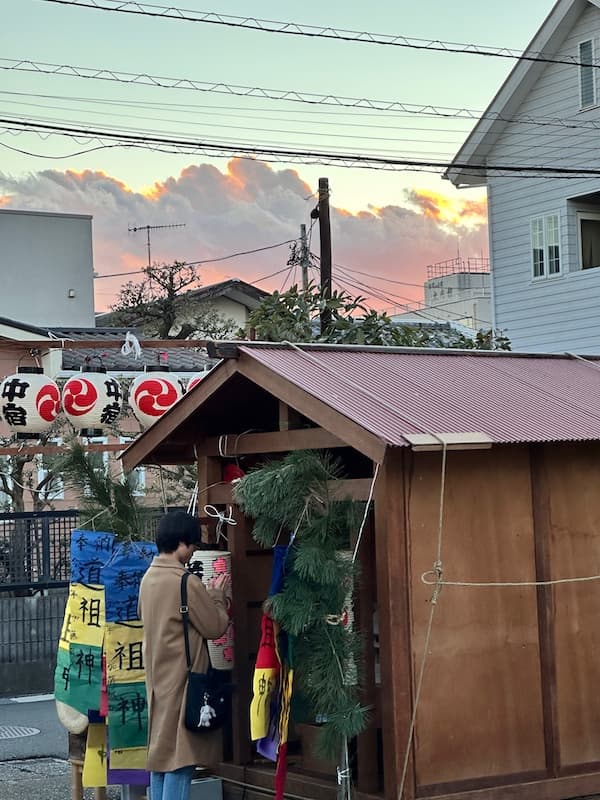
But for a quicker and equally pleasant option, you can rent a bike from the Tourism Information Center located in front of the station (¥500 per rental plus a ¥2,000 deposit) or use Hello Cycling, a bike-sharing app widely available in the Tokyo area.
Rental prices through Hello Cycling range from ¥1,800 to ¥3,000 for a 12-hour period, depending on the bike type. To use Hello Cycling, you’ll need to download the app, create an account, and register a payment method. It’s a good idea to set this up in advance to avoid any last-minute issues.
Cycling is a fun and active way to see the town, but be aware that there are some uphill and downhill areas, which might be tough if you’re not used to biking.
And of course, buses and taxis are also available for those who prefer not to walk or bike. The town is small enough that getting around is straightforward, no matter your choice.
Oiso’s Sagicho Fire Festival
If you’re visiting Oiso in mid-January, make sure to check out the Sagicho Festival. This traditional fire festival takes place every year on Oiso Beach and has been celebrated for over 400 years. It’s not widely known even among Japanese people, so if you’re looking to experience authentic Japan beyond the typical tourist spots, this is a must-see. I’ve participated myself and highly recommend it.
What is the Sagicho Festival?
The Sagicho Festival is a way for locals to mark the end of the New Year celebrations. People gather their old decorations and bring them to the beach, where they’re stuffed into massive bamboo-and-pine structures called saito, dedicated to the local guardian deity called Dosojin. These saito are burned in the evening as part of the ritual to purify the past year and pray for good fortune in the year ahead.
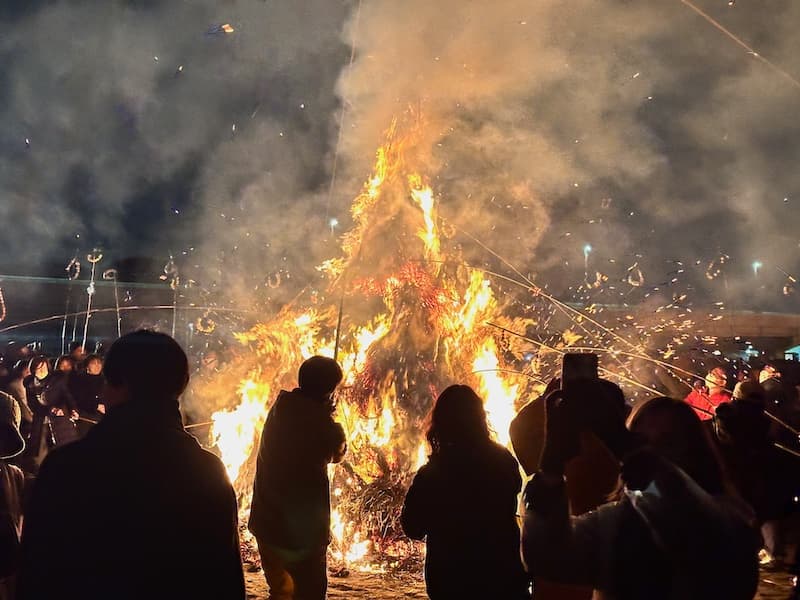
The Sagicho Festival is held in various part of Japan, but Oiso’s version stand out with several unique events:
- Ihciban Musuko which marks the start of the festival. Children carry stones tied with ropes and visit local homes, pounding the ground with the stones while chanting wishes for the happiness of the residents. This symbolizes driving the evil spirits back into the depth fo the earth.
- The Yannagokko tug-of-war takes place in the sea, on the night of the festival. Men dressed in fundoshi (traditional loincloths) run into the freezing ocean as part of a ritual that symbolizes driving away evil spirits and praying for a bountiful harvest.

The Preparations
The festival technically begins weeks in advance with preparations for the saito bonfires. In total, there are nine saito. Preparations intensify on the day of the festival, as locals bring their decorations to the beach to burn and help put the finishing touches on the saito. Since each saito represents a district in Oiso, residents from each area gather around their respective bonfires.

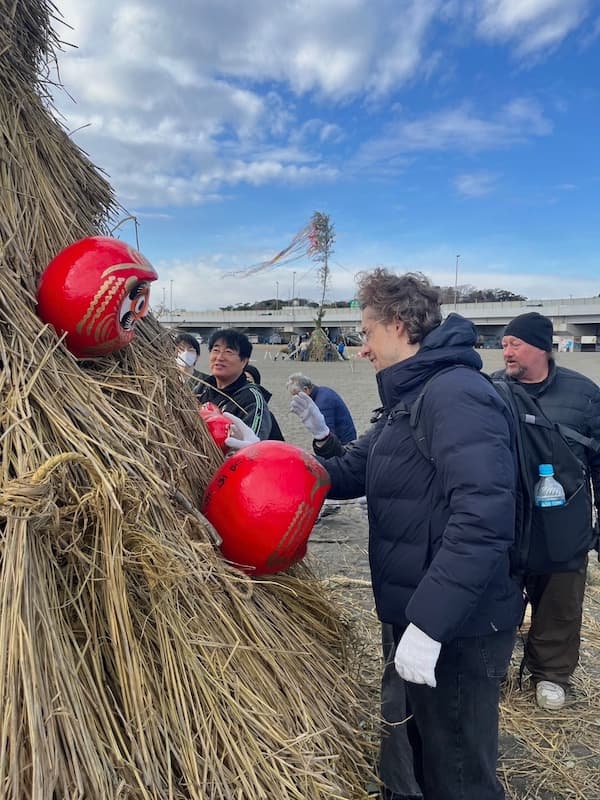
The atmosphere is lively and friendly, with people chatting and working together to ensure everything is ready. On the day of the festival, attendees also prepare dango (rice dumplings), which are meant to be roasted over the saito fires later in the evening.
If you’re in Oiso on the day of the festival, don’t miss the chance to visit Oiso Beach in the morning to witness the hustle and bustle of locals preparing their saito. If you approach them, they’ll likely be happy to chat with you and even invite you to join in the preparations.
What to Expect at the Festival
Saito Bonfires
The saito are lit around 6:30pm, and the entire beach comes alive with light. The flames are massive, and the heat is intense when you get close to the saito. With no barriers and both older people and children running around the enormous bonfire, the atmosphere feels a bit wild.

The wind moves the flames from side to side, sending sparks flying into the crowd. At one point, the bamboo structure collapses, and the crowd has to quickly move out of the way to dodge it. This slight sense of danger combined with the roaring fire is part of what makes the experience so thrilling.
Roasting Dango
Visitors to the festival carry long bamboo sticks with dango attached to the ends. The idea is to roast the dango over the fire, as eating them is believed to bring good health for the year ahead. But it’s easier said than done. Holding the bamboo stick from one end while getting close enough to the intense flames is harder than it looks. For a start, it’s actually heavy. Then, you’ll likely find yourself stepping back several times just to cool off from the intense heat emanating from the fire.

Yannagokko Ritual
The festival’s final event is the Yannagokko ritual. Men from the town dressed in nothing else than a fundoshi run into the sea and mimic a tug-of-war game with other men on the beach. In the middle of the rope sits a sleigh with a box on top, which is believed to contain an evil spirit. After the symbolic tug-of-war ends, the men carry the box out of the water and break it.
Then, they sit on the sleigh—still dressed in just their fundoshi—and are pulled off the beach and into the town by locals and festival visitors. The sleigh makes its way to the district shrine, stopping occasionally for a traditional chant.
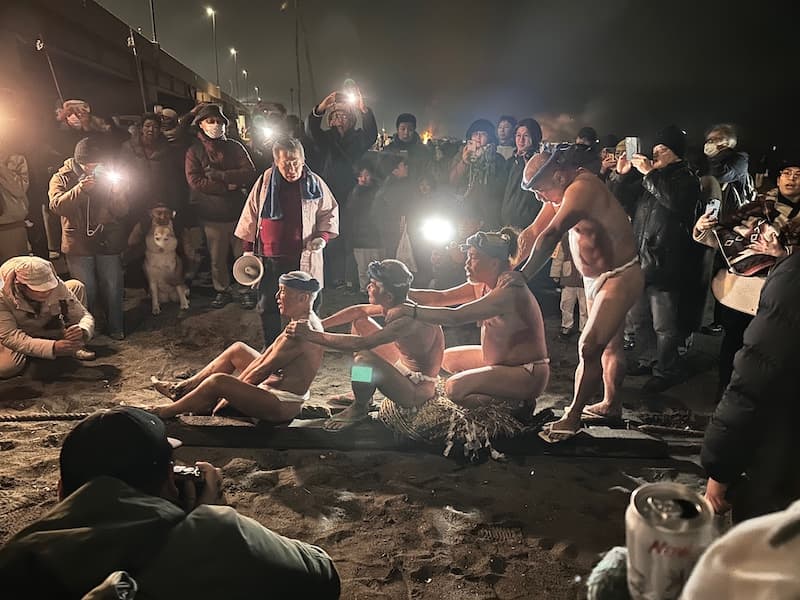
The whole process takes about 30 minutes, and yes, the men remain in their fundoshi throughout—at night, in the middle of January, in the freezing Japanese countryside, after taking a dip in the ocean.
Once they arrive at the shrine, they’re welcomed with sake and tofu, which is also offered to everyone who helped pull the sleigh. This Yannagokko part of the festival is actually really fun to watch and join. The energy is high, and the crowd gets really into it, cheering and celebrating together.
Tips for Attending
- Arrive 30 minutes to one hour before: There’s no need to worry about specific seating, but arriving a little early lets you soak up the atmosphere before the festivities begin.
- How to dress: January nights can be cold, but the crowds and the fire will keep you warm, so you likely won’t feel chilly. Just keep in mind that your clothes will smell like smoke afterwards, so it’s probably best to leave your brand new Burberry long coat you got for Christmas at the hotel.
The Sagicho Festival is raw, exciting, and full of energy. Unlike most festivals, it has a truly local vibe, and you’ll feel like an active participant rather than just part of the audience. If you’re in Oiso in January, I strongly recommend you check it out.
The Bottom Line
Oiso might not be as well-known as towns like Kamakura or Kawagoe, but that’s exactly what makes it special. Interestingly, the famous author Haruki Murakami (Kafka on the Shore, 1Q84) resides here. It’s easy to see why—the quiet atmosphere and local life have a unique appeal. Away from the crowds and non-touristy, I was also really impressed by this quiet little town. Its peaceful vibe is a refreshing change from Tokyo’s busyness. People are friendly too. For instance, the clerk at the convenience store near the station was surprised to meet foreigners who could speak Japanese and started chatting with us. That’s something you’d probably never experience in the cities part of the usual Japan trip itinerary.

